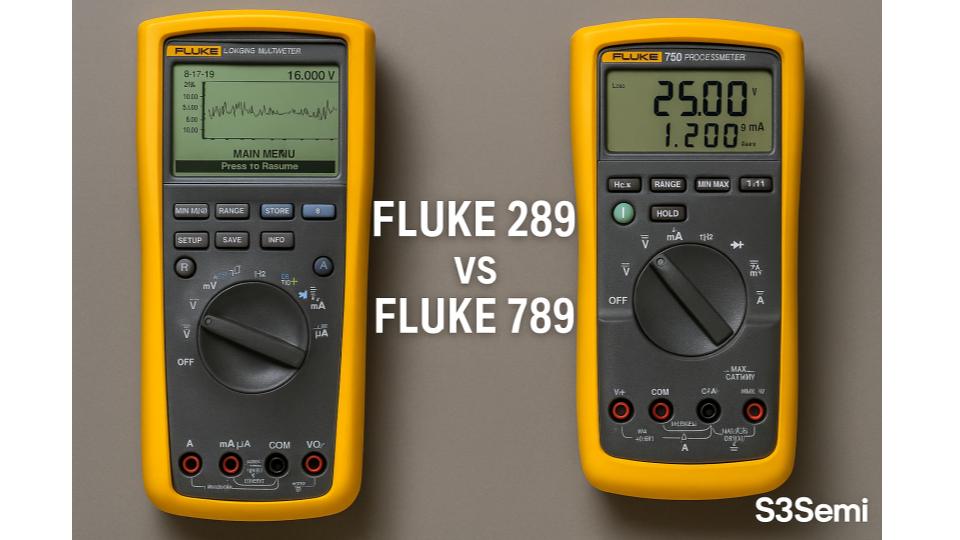Two of Fluke’s most advanced meters – the289 and 789, often get compared because they both deliver top-tier performance for industrial and process applications.
🏷️ Fluke Calibrator Deals ⭐⭐⭐⭐
However, they are intended for slightly different applications: the 289 is a data-logging multimeter, while the 789 is a process-calibrating multimeter with built-in current sourcing.
Let’s explore their features, differences, and which one is right for your work.
🔍 Overview of the Fluke 289
The Fluke 289 is part of Fluke’s premium logging multimeter lineup. It’s designed for engineers, technicians, and industrial users who need to analyze electrical trends and troubleshoot complex systems.
Key Features:
- True RMS for accurate measurement on non-linear loads
- Data logging with built-in TrendCapture™ graphing
- High-resolution 50,000-count display (digitally enhanced to 500,000 counts)
- Measures AC/DC voltage, current, resistance, frequency, and capacitance
- Records and stores multiple measurement sessions
- USB connectivity for PC data analysis
- CAT IV 600 V / CAT III 1000 V safety rating
- Optional infrared interface for PC connectivity
Best For: Engineers and industrial technicians needing long-term data logging, troubleshooting intermittent faults, and high-accuracy readings.
⚙️ Overview of the Fluke 789
The Fluke 789 ProcessMeter is a unique combination of a multimeter and loop calibrator.
It’s built for process control professionals who need to measure and source current in 4–20 mA loops, making it ideal for instrumentation and automation work.
Key Features:
- Combines multimeter + loop calibrator functions
- 24 V loop supply to power transmitters directly
- Source / simulate / measure 4–20 mA current loops
- Dual display for simultaneous measurement and sourcing
- True RMS AC voltage and current measurements
- 250 Ω HART resistor for compatibility with HART devices
- Data hold, Min/Max/Average recording
- CAT III 1000 V / CAT IV 600 V safety rating
Best For: Process technicians, control engineers, and calibration specialists working with transmitters, PLCs, and industrial automation systems.
📊 Side-by-Side Comparison
| Feature | Fluke 289 | Fluke 789 |
|---|---|---|
| Type | Logging Digital Multimeter | ProcessMeter (Multimeter + Loop Calibrator) |
| Display | High-res dot-matrix LCD with TrendCapture™ | Dual numeric display |
| Data Logging | ✅ Yes (built-in memory and graphing) | ⚠️ Limited (only Min/Max recording) |
| Current Sourcing | ❌ No | ✅ Yes (4–20 mA loops) |
| Loop Power Supply | ❌ No | ✅ 24 V DC supply |
| Frequency Range | Up to 1 MHz | Up to 100 kHz |
| Voltage Range | Up to 1000 V AC/DC | Up to 1000 V AC/DC |
| Current Range | Up to 10 A | Up to 1 A (20 mA source/simulate) |
| Logging Capability | Extensive with USB/PC connectivity | Basic (Min/Max/Average) |
| Battery Life | ~100 hours | ~140 hours |
| Target User | Industrial troubleshooting & analysis | Process control & calibration |
| Safety Rating | CAT IV 600 V / CAT III 1000 V | CAT III 1000 V / CAT IV 600 V |
| 💳 Pricing | 💲 Check Price | 💲Check Price |
✅ Pros and Cons of Each
Fluke 289 Pros
- Extensive data logging and graphing functions
- High-resolution display with TrendCapture™
- Excellent accuracy and True RMS readings
- Perfect for long-term monitoring and analysis
Fluke 289 Cons
- More expensive than standard DMMs
- Bulkier and heavier than handheld models
- Not designed for current loop sourcing
Fluke 789 Pros
- Combines DMM and loop calibrator in one tool
- 24 V loop power for transmitters and PLCs
- Built-in 250 Ω HART resistor for field use
- Excellent for process automation and maintenance
Fluke 789 Cons
- No graphing or extensive data logging
- Single-function current loop sourcing limits range
- Lower frequency measurement limit
🏆 Verdict: Fluke 289 or Fluke 789?
Both meters are exceptional professional-grade tools from Fluke—but they’re meant for different applications.
- Choose the Fluke 289 if you’re an electrical engineer or industrial technician who needs advanced logging, graphing, and long-term trend analysis. It’s essential for troubleshooting intermittent faults and documenting system performance.
- Choose the Fluke 789 if you’re a process technician or instrumentation specialist working with 4–20 mA loops and transmitters. It combines measurement and calibration in one device, saving time and space in the field.
👉 In short:
- Fluke 289 = Data-logging multimeter for electrical analysis.
- Fluke 789 = Process calibrator multimeter for industrial automation.





